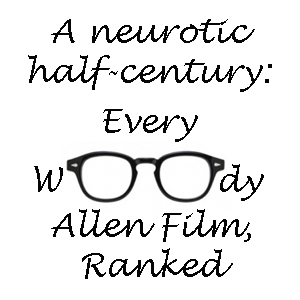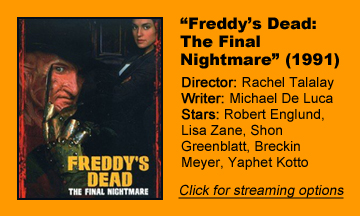From Sept. 18-Oct. 16, we’re looking back at the nine films of the “Nightmare on Elm Street” franchise. Next up is the sixth film, “Freddy’s Dead: The Final Nightmare” (1991):
Time capsule of 1991
“Freddy’s Dead: The Final Nightmare” has that same problem as the “Friday the 13th” films wherein it tells the audience it has jumped ahead – 10 years in this case – yet it remains very much in its own time. I guess slasher filmmakers were willing to sacrifice historical respectability to give theatergoers the briefest (fake) thrill of peeking into the future. But despite technically being set in 2001, “Freddy’s Dead” actually plays as a fun time capsule of 1991.
Director Rachel Talalay, who developed the story scripted by Michael De Luca, notably moves the action into a new decade (if not a new century), dispensing with the dour Alice storyline of parts 4–5.
Although “Freddy’s Dead” fails to find grounded situations or introduce people we like enough to care about their fate, Talalay delivers a romp that’s easier to watch than her later “Tank Girl” (1995) – her most famous credit because it made her the first female superhero film helmer.
A mid-film psychedelic sequence plays like an early ’90s Nintendo advertisement as Spencer (Breckin Meyer) hops around like Mario while he’s controlled by Freddy (Robert Englund, again top-billed). Freddy compares his knife-fingered glove to the Power Glove.
The soundtrack includes a remarkable amount of Goo Goo Dolls, flannel-wearing Tracy (Lezlie Deane) fits the depressive grunge mold, a Johnny Depp “This is your brain on drugs” commercial gets skewered, and the whole film has a polished new-decade feel.
Breaking free of formula
And Talalay shows a willingness to break free of formula – or at least crank the formula to 11 to fool us into thinking it’s new. Youth counselor Maggie (Lisa Zane) – herself rather young, although not as ridiculously so as Heather Langenkamp’s supposed doctor in part three – leads Spencer, Tracy, Carlos (Ricky Dean Logan) and amnesiac “John Doe” (Shon Greenblatt) into nearby Springwood, Ohio, searching for answers.
“Freddy’s Dead” spends more time in the dreamscape than any film so far, and even when it’s in the real world, it’s surreal. Springwood – whether the real or dream version — has been warped by Freddy’s depredations: The remaining adults (including Roseanne Barr and Tom Arnold in cameos) have devolved into nuttiness in a town where all the kids have disappeared.
The story doesn’t exactly go in a revelatory direction, but I appreciate that it’s tight, at least. “Alien’s” Yaphet Kotto plays Doc, who specializes in dream studies, and everyone is so quickly immersed in Freddy’s world that we can thankfully skip over explanations to Doubting Thomases.
A decent mystery kicks in as we wonder which of the characters is Freddy’s kid, and we get a more complete version of the villain’s backstory. He was bullied when he was a kid, then took that out on the next generation, although (conveniently for the sake of this movie’s existence) not upon his own offspring, until now.

For a half-second, “Freddy’s Dead” asks us to forgive Freddy because he’s a product of society and never received the help he needed. But he’s so in control of his own actions – and always has been in these six films – that Talalay and De Luca pull back before we’ve had time to absorb any complexity.
A wild romp
There’s also a rather striking shot where Freddy is framed from below, backed by moving moonlit clouds as he declares that “every town has an Elm Street.” Again, for a split-second, we’re asked to consider the darkness in the shadows of all American towns.
But then it’s back to the romp, which sometimes is diverting (the Nintendo sequence, and another wherein the teens can’t escape Springwood because they are magically driving in circles) and sometimes painful (Carlos’ overlong nightmare that features Freddy’s nails on a chalkboard).
It all leads to a 3D grand finale, the start of which is signaled by Maggie donning 3D glasses as she enters the dreamscape. Obviously, this stuff doesn’t play as well on a 2D TV, but I can see how it might’ve been goofy fun in the theater.
As with all the other “Nightmare on Elm Street” films, the execution falls short of the ideas. Even when we get Freddy’s full background and find out which of the characters is his offspring, it’s hard to care all that much; this ain’t exactly “The Empire Strikes Back.” That said, Talalay brings an energy the previous sequels lack.
The saga is still pretty tired, as ’90s kids patiently await a slasher franchise of their own (who knew that “Nightmare” creator Wes Craven would be the one to provide it), but “Freddy’s Dead: The Final Nightmare” briefly sparks this old one back to life.
Click here to visit our Horror Zone.

“A Nightmare on Elm Street” series reviews
Friday, Sept. 18: “A Nightmare on Elm Street” (1984)
Wednesday, Sept. 23: “A Nightmare on Elm Street 2: Freddy’s Revenge” (1985)
Friday, Sept. 25: “A Nightmare on Elm Street 3: Dream Warriors” (1987)
Wednesday, Sept. 30: “A Nightmare on Elm Street 4: The Dream Master” (1988)
Friday, Oct. 2: “A Nightmare on Elm Street 5: The Dream Child” (1989)
Wednesday, Oct. 7: “Freddy’s Dead: The Final Nightmare” (1991)
Friday, Oct. 9: “Wes Craven’s New Nightmare” (1994)
Wednesday, Oct. 14: “Freddy vs. Jason” (2003)
Friday, Oct. 16: “A Nightmare on Elm Street” (2010)


